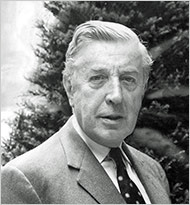Sir Frederick Ashton
|
Sir Frederick Ashton OM CH CBE |
|
|---|---|
 |
|
| Born |
Frederick William Mallandaine Ashton 17 September 1904 Guayaquil, Ecuador |
| Died | 18 August 1988 (aged 83) Chandos Lodge, Eye, Suffolk, England |
| Nationality | British |
| Occupation | Choreographer |
| Years active | 1926–1980 |
| Notable work |
|
Sir Frederick William Mallandaine Ashton OM CH CBE (17 September 1904 – 18 August 1988) was a British ballet dancer and choreographer. He also worked as a director and choreographer in opera, film and revue.
Determined to be a dancer, despite the opposition of his conventional middle-class family, Ashton was accepted as a pupil by Léonide Massine and then by Marie Rambert. In 1926 Rambert encouraged him to try his hand at choreography, and though he continued to dance professionally, with success, it was as a choreographer that he became famous.
Ashton was chief choreographer to Ninette de Valois, from 1935 until her retirement in 1963, in the company known successively as the Vic-Wells Ballet, the Sadler's Wells Ballet and the Royal Ballet. He succeeded de Valois as director of the company, serving until his own retirement in 1970.
Ashton is widely credited with the creation of a specifically English genre of ballet. Among his best-known works are Façade (1931), Symphonic Variations (1946), Cinderella (1948), La fille mal gardée (1960), Monotones I and II (1965), Enigma Variations (1968) and the feature film ballet The Tales of Beatrix Potter (1970).
Ashton was born in Guayaquil, Ecuador, the fourth of the five children of George Ashton (1864–1924) and his second wife, Georgiana (1869–1939), née Fulcher. George Ashton was manager of the Central and South American Cable Company and vice-consul at the British embassy in Guayaquil. In 1907 the family moved to Lima, Peru, where Ashton attended a Dominican school. When they returned to Guayaquil in 1914, he attended a school for children of the English colony. One of his formative influences was serving as altar boy to the Roman Catholic Archbishop, which inspired in him a love of ritual. Another, still more potent, influence was being taken to see Anna Pavlova dance in 1917. He was immediately determined that he would become a dancer.
...
Wikipedia
